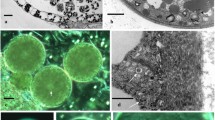Abstract
Structural members within the exospore ofSelaginella galeottii suggestive of those present at maturity are first detectable when the exospore is approximately 5 µm in thickness. Subsequent changes in successively larger sporangia involve a gradual size increase of the component units simultaneously throughout the exospore. Concomitantly, non-membrane bound material present at the inner surface of the tapetum (and the persistent megasporocytes) and throughout the sporangium locule changes from primarily droplets and weftlike material (including beaded wefts) to coarse fibrous material. The taxa which possess this unusual wall pattern cut across presently accepted taxonomic schemes. This is not the case with the other wall ultrastructural types in the genus. The possibility exists that this megaspore wall type defines a separate lineage within the genus which, by virtue of its large megaspores, was able to compete well and radiate to produce a variety of life forms.
Similar content being viewed by others
References
Afzelius, B. M., Erdtman, G., Sjostrand, F. S., 1954: On the fine structure of the outer part of the spore wall ofLycopodium clavatum as revealed by the electron microscope. — Svensk Bot. Tidskr.48: 151–161.
Bergad, R. D., 1978: Ultrastructural studies of selected North American Cretaceous megaspores ofMinerisporites, Erlansonisporites, Horstisporites, andRicinospora, n. gen. — Palynology2: 39–51.
Buchen, B., Sievers, A., 1978: Megasporogenese vonSelaginella. II. Ultrastrukturelle und cytochemische Untersuchungen zur Sekretion von Lipiden. — Protoplasma96: 319–328.
Huckriede, R., 1982: Die unterkretazische Karsthöhlen Füllung von Nehden im Sauerland. 1. Geologische, paläozoologische und paläobotanische Befunde und Datierung. — Geol. Palaeontol.16: 183–242.
Hueber, F. M., 1982: Megaspores and a palynomorph from the Lower Potomac Group in Virginia. — Smithsonian Contrib. Paleobiol.49: 1–69.
Kempf, E. K., 1970: Elektronenmikroskopie der Sporodermis von Megasporen der GattungSelaginella (Pteridophyta). — Rev. Palaeobot. Palynol.10: 99–116.
Minaki, M., 1984: Macrospore morphology and taxonomy ofSelaginella (Selaginellaceae). — Pollen & Spores26: 421–480.
Pettitt, J. M., 1971a: Some ultrastructural aspects of sporoderm formation in pteridophytes. — InErdtman, G., Sorsa, P., (Eds.): Pollen and spore morphology/plant taxonomy.Pteridophyta, pp. 227–251. — Stockholm: Almqvist & Wiksells.
—, 1971b: Developmental mechanisms in heterospory I. Megasporocyte degeneration inSelaginella. — Bot. J. Linn. Soc.64: 237–246.
Stainier, F., 1966: Morphological study of the walls of the mega- and microspores ofSelaginella myosurus (Sw.)Alston. — Rev. Palaeobot. Palynol.3: 47–50.
Taylor, W. A., 1989: Comparative analysis of sporoderm ultrastructure in fossil and extant lycopods. — Ph.D. Dissertation, The Ohio State University, Columbus, Ohio.
- 1990: Megaspore wall ultrastructure inSelaginella. — Pollen & Spores (in press).
—, Taylor, T. N., 1988: Ultrastructural analysis of selected megaspores from Argentina. — J. Micropalaeontol.7: 73–87.
Tryon, A. F., 1949: Spores of the genusSelaginella in North America north of Mexico. — Ann. Missouri Bot. Gard.36: 413–431.
—, Lugardon, B., 1978: Wall structure and mineral content inSelaginella spores. — Pollen & Spores20: 315–340.
Venable, J. H., Coggeshall, R., 1965: A simplified lead citrate stain for use in electron microscopy. — J. Cell Biol.5: 407.
Author information
Authors and Affiliations
Rights and permissions
About this article
Cite this article
Taylor, W.A. Ultrastructural analysis of sporoderm development in megaspores ofSelaginella galeottii (Lycophyta). Pl Syst Evol 174, 171–182 (1991). https://doi.org/10.1007/BF00940338
Received:
Accepted:
Issue Date:
DOI: https://doi.org/10.1007/BF00940338




